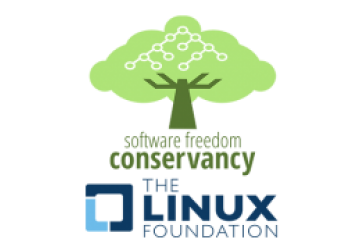Why We Need Our Nonprofits

A confession: before I heard Bradley Kuhn's talk at Freenode.live last November, I didn't know that HDMI was a proprietary interface. I just assumed that HDMI was like VGA, USB and dozens of other standardized ways to connect the jacks on two devices through a cable with plugs at both ends. I did assume a cabal of companies was behind HDMI, but I didn't know that only "adopters" could make HDMI stuff, and that being an adopter required paying serious money to something called HDMI Licensing LLC.
I also didn't know there was a FLOSS story behind VGA. "We spent probably two decades getting VGA just to work everywhere", Bradley explained. And now, even though most projectors still respect VGA, "the presumed setup" for a presenter, he said, "is a proprietary HDMI connector". He didn't like that and now I don't either.
Could we have prevented HDMI from becoming what it is? Can we prevent the all-proprietary future of hardware and interfaces from coming to pass? This is a huge question, since the whole tech world seems to be moving in an embedded direction, with Linux and FLOSS goods (and values) buried deep inside proprietary and closed devices.
Bradley works with the Software Freedom Conservancy, a non-profit home and organizational infrastructure for FLOSS projects. It's an essential service. Git is there. So are Boost, Busybox, Samba, Squeak, Sugar, Wine and many others.
The Linux Foundation has also become essential. While I already knew that, it became clear to me in a new way today when I read about a new thing called CHIPS Alliance. According to the Linux Foundation's press release, "CHIPS Alliance will foster a collaborative environment that will enable accelerated creation and deployment of more efficient and flexible chip designs for use in mobile, computing, consumer electronics, and Internet of Things (IoT) applications....The project will create an independent entity so companies and individuals can collaborate and contribute resources to make open source CPU chip and system-on-a-chip (SoC) design more accessible to the market."
Also this: "Early CHIPS Alliance backers include Esperanto Technologies, Google, SiFive and Western Digital, all committed to both open source hardware and continued momentum behind the free and open RISC-V architecture."
The RISC reference piqued my interest, because I have history there, which I'll visit shortly. Meanwhile, Wikipedia:
RISC-V (pronounced "risk-five") is an open-source hardware instruction set architecture (ISA) based on established reduced instruction set computer (RISC) principles.
The project began in 2010 at the University of California, Berkeley, but many contributors are volunteers not affiliated with the university.[1]
As of March 2019, version 2.2 of the user-space ISA is frozen, permitting most software development to proceed.
To the question, "How does CHIPS Alliance relate to the RISC-V Foundation?" the CHIPS Alliance FAQ explains, "CHIPS Alliance aims to host implementation efforts around RISC-V architecture (RISC-V is only for ISAs and will not host implementations). RISC-V will help set up an ISA instruction set, but will then need open sourced chip designs; CHIPS Alliance will create that open source standard computing design. Members and participants of CHIPS Alliance will then be able to download source code and compile binaries to get Linux running and offer a fully functional CPU or SoC design with RISC-V."
I have history with RISC (Reduced Instruction Set Computing). Back in the late 1980s, not long after Sun Microsystems created the spec for its RISC-based SPARC CPU, Sun convened a cabal of chip manufacturers as a trade group with a shared interest in competing for Sun's business. That trade group was SPARC International, and for a while SPARC International's only phone was one that rang on my desk. See, my little company's job was making SPARC International a functioning thing. This wasn't easy, because all the companies with SPARC ambitions—Atmel, Bipolar Integrated Technology, Cypress Semiconductor, Fujitsu, LSI Logic, Matsushita, Solborne and Texas Instruments, among others—were competing chip makers who hated each other as only chip makers can.
Complicating things was the nature of chip makers as mills that massively produce patents and other forms of intellectual property, and do that within bubbles of absolute secrecy. This also conflicted with another of SPARC International's jobs: making sure the spec remained "open, non-proprietary and royalty free".
In the midst of trying to hold SPARC International together, I ran into Andy Grove, the legendary CEO of Intel and one of the world's most blunt communicators. While explaining what I was doing with SPARC, Andy said, "I'll sell more CPUs in the next hour than you'll sell SPARCs in a year", and walked away.
SPARC was at best a relatively small success. But RISC did succeed, massively, with ARM (which stands for Advanced RISC Machine). ARM started as the Acorn RISC Machine in 1983. Today, most of the world's mobile devices run ARM chips.
I don't know how well the CHIPS Alliance will do, but I do know that only an entity big and experienced enough to pull giant competing companies together can do it. For Linux, that's the Linux Foundation. I'm glad we have it.
I'm also glad we have the Software Freedom Conservancy. Times are getting tough for FLOSS, and we need all the help we can get.










